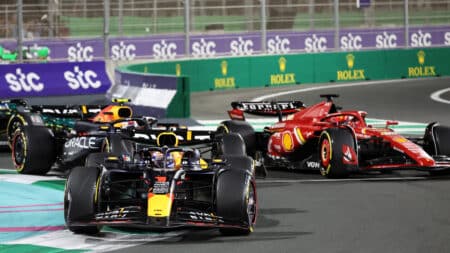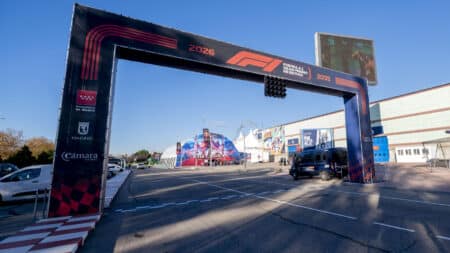
Which Red Bull will show up in Jeddah? - What to watch for at Saudi GP
Can Red Bull rebound from its poor Bahrain showing? And will it be Piastri or Norris leading McLaren's charge? Here's the five themes to watch for at the Saudi Arabian GP
Honda’s motor sport chief Yasuhisa Arai went into F1’s summer break shooting from the hip and sounding very gung-ho about the progress he expects from the ‘Phase 3’ version of the motor in the back of the McLarens from this coming weekend.
The double points finish in Hungary for Fernando Alonso and Jenson Button was, he said, a reflection of the fact that Honda had finally got on top of the heat rejection problems that had been keeping the ersH from running at anything like its full capacity. This in turn meant the turbo was not running at maximum efficiency, meaning a double-sourced shortfall of power and/or excess of fuel consumption.

With that now under control, he reported, it was time to unleash the performance upgrades. These comprise redesigns for the combustion chamber, inlet and exhaust systems and the ersK gear train. The combined effect, suggests Arai, will be Ferrari-matching horsepower.
Which on the surface is a rather bold claim, given how far behind the Honda has been to date. Sonic and GPS data suggest it has been around 130bhp down on Mercedes in qualifying – sometimes more, sometimes less, depending upon how much ersH they dared use – and more in the races.
In Montréal an overlay of speed traces of the Mercedes and the McLaren out of the final chicane and down the pitstraight painted a very vivid picture – one in which the exit speed and initial acceleration were comparable, but in which the Merc kept accelerating hard long after the McLaren was struggling for every extra kph. The McLaren had essentially flat-lined long before the start/finish straight, the power overcome by the squaring resistance of the air at a place where the Merc was still thundering onwards.

At Hungary, Arai suggests, the motor was already better than the Renault – a claim that has raised more than a few eyebrows. We didn’t see the full qualifying potential of the McLaren-Hondas at the Hungaroring because of the separate electrical problems that afflicted both cars at crucial moments. But although the practices suggested they may have had the pace to have got into Q3, there was no indication they were a potential match for the Renault-powered Red Bulls which in Hungary were vying with Ferrari as best of the rest behind Mercedes. Arai infers that is down to the respective chassis.
Arai, a very measured man and with a limited grasp of English, has remained inscrutable all year as he’s faced a barrage of questions about the lamentable performance of the engines, but in the summer break, for the first time, he bared his teeth. In Honda’s mid-season review, he stated (emphasis ours): “I think Honda’s development method is very different to Formula 1 and McLaren. I think that I have what it takes to drive this project, but I can’t decide my own future. Neither can the media or McLaren board members. I hope to continue driving this project and I believe that our board members trust me emphatically.”
It hints at the enormous pressures and the resultant politicking behind the scenes arising in this case from the mismatch between the perspectives of a race team and its engine partner. You can read more of this in a feature within the current magazine, but McLaren has clearly been pushing hard in trying to force the pace of Honda’s development and using everything in its power to do so. Feathers have undoubtedly been ruffled.

During interviews in Hungary, Arai detailed other areas aside from the power unit he believed were losing lap time – and didn’t hold back. Mechanical grip was lacking, he claimed, and the aero performance was well behind Red Bull’s – though he did concede the latter was partly down to Honda unreliability during the off-season resulting in a lack of aero testing. McLaren doesn’t go on record in assessing relative ‘blame’ for the lack of performance so far, but privately believes its car ranks third in terms of aero.
So the promise of Ferrari-level horsepower this weekend is an exciting prospect. The layout of Spa, with the super-long straights of sectors one and three, combined with the high speed aero demands of sector two, should make it very plain where any respective strengths and weaknesses lie. If Arai’s bold claims are borne out, the pressure could switch to McLaren. On the other hand, if the engine is as good as Arai hopes and the chassis as good as McLaren believes it to be – not the best, but pretty good – then there’s no reason why Alonso and Button shouldn’t be mixing it with the Ferraris.
A lot of ifs in there, though…

Can Red Bull rebound from its poor Bahrain showing? And will it be Piastri or Norris leading McLaren's charge? Here's the five themes to watch for at the Saudi Arabian GP

McLaren's breakthrough in a near-four-year-old ruleset shows F1 rules convergence is a myth – just like Sebastian Vettel, Red Bull and Renault did in 2013, writes Mark Hughes

Madrid finally has a consortium to build the new Formula 1 circuit that will host the 2026 Spanish GP

Helmut Marko caused a stir after the Bahrain GP with his worries that Max Verstappen could leave Red Bull early. But how real are those fears?